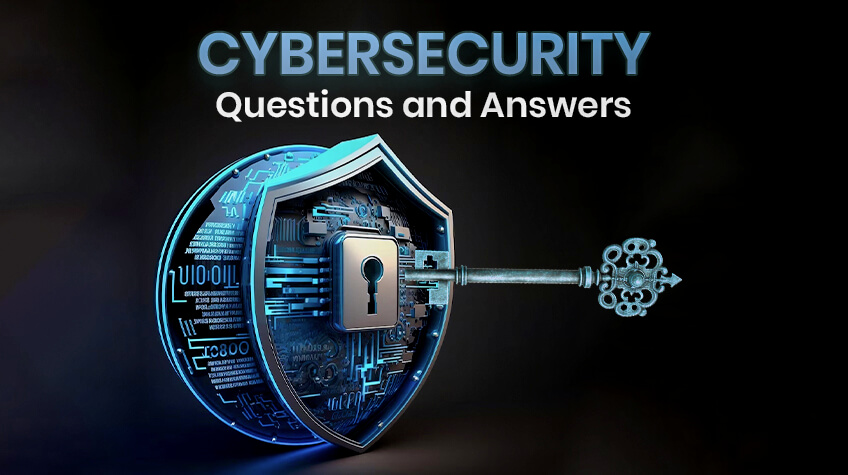
Introduction
In the dynamic landscape of today’s digital era, cybersecurity serves as a sentinel against a growing array of threats. As organizations increasingly recognize the importance of safeguarding their digital assets, the demand for adept cybersecurity experts has reached phenomenal heights. For freshers aspiring to carve their niche in this critical field, success hinges on mastering the intricacies of cybersecurity interview questions and answers.
This blog serves as a compass, guiding newcomers through the labyrinth of common cybersecurity interview questions and answers. Join us as we unravel the core concepts and best practices essential for surviving and excelling in cybersecurity interviews.
Here are 25 Cybersecurity interview questions and answers
Q1. What is the primary role of cybersecurity?
Answer: Cybersecurity safeguards digital systems and data, focusing on maintaining confidentiality, integrity, and availability to counter unauthorized access or data compromise.
Q2. What is the dissimilarity between symmetric and asymmetric encryption?
Answer: Symmetric encryption uses a single key for encryption and decryption, while asymmetric encryption employs a pair of public and private keys for secure communication.
Q3. How does a firewall improve network security?
Answer: Firewalls act as barriers, monitoring and controlling traffic to prevent unauthorized access ensuring a secure network environment.
Q4. Define malware and provide an example.
Answer: Malware, or malicious software, includes harmful programs like viruses. An example is a computer virus that infects and spreads within a host system.
Q5. Explain the significance of the CIA triad in cybersecurity.
Answer: The CIA triad—confidentiality, integrity, and availability—forms the cornerstone of cybersecurity, ensuring data remains secure, unaltered, and accessible as needed.
Q6. What is a VPN, and why is it crucial for cybersecurity?
Answer: A VPN, or Virtual Private Network, encrypts internet traffic, providing a secure connection that protects sensitive data from potential interception.
Q7. Differentiate between vulnerability and exploit.
Answer: A vulnerability is a system weakness, while an exploit is the means attackers use to take advantage of that weakness and compromise security.
Q8. How can DDoS attacks be mitigated?
Answer: Mitigating DDoS attacks involves traffic filtering, load balancing, and utilizing content delivery networks (CDNs) to distribute and handle traffic.
Q9. What are zero-day vulnerabilities, and why are they concerning?
Answer: Zero-day vulnerabilities are newly discovered weaknesses in software without available fixes, posing a significant threat as attackers can exploit them before developers provide a patch.
Q10. Explain the difference between an IDS and an IPS.
Answer: An IDS (Intrusion Detection System) detects and logs potential security incidents, while an IPS (Intrusion Prevention System) actively blocks or prevents detected threats.
Q11. What is the role of antivirus software in cybersecurity?
Answer: Antivirus software detects, prevents, and removes malicious software, protecting systems from viruses, worms, trojans, and other types of malware.
Q12. Define penetration testing and its significance.
Answer: Penetration testing is a proactive security measure involving simulated attacks to identify vulnerabilities and assess the overall resilience of a system or network.
Q13. How does two-factor authentication enhance security?
Answer: Two-factor authentication requires users to provide two forms of identification, typically a password and a unique code sent to their mobile device.
Q14. What is a SIEM system, and why is it valuable?
Answer: An SIEM (Security Information and Event Management) system collects, analyzes, and correlates log data from various sources, offering comprehensive insights into an organization’s security posture.
Q15. Explain the purpose of a honeypot in cybersecurity.
Answer: Honeypots are decoy systems used to attract and study cyber attackers, helping security professionals understand their tactics and gather valuable threat intelligence.
Q16. What is the principle of least privilege?
Answer: The principle of least privilege advocates providing users with the lowest level of access and permissions required to perform their job functions, reducing the risk of unauthorized activities.
Q17. How can employees contribute to organizational cybersecurity?
Answer: Employees play a crucial role by staying vigilant, adhering to security policies, attending training sessions, and promptly reporting suspicious activities or potential security incidents.
Q18. Why is regularly updating software and systems necessary for cybersecurity?
Answer: Regular updates address known vulnerabilities, patch security flaws, and improve system performance to thwart potential exploitation by cyber threats.
Q19. Define social engineering and methods to prevent it.
Answer: Social engineering involves manipulating individuals to reveal sensitive information. Prevention involves awareness training, verification protocols, and skepticism toward unsolicited communications.
Q20. What does the term “security mindset” entail?
Answer: A security mindset involves a proactive approach to identifying and mitigating security risks, prioritizing protecting data and systems in daily activities.
Q21. What is the significance of multi-factor authentication in cybersecurity?
Answer: Multi-factor authentication enhances access controls by requiring multiple forms of identification, such as a password, fingerprint, or security token, enhancing access controls.
Q22. Define the term “phishing” and discuss preventive measures.
Answer: Phishing involves fraudulent attempts to obtain sensitive information. Prevention includes user education, email filtering, and implementing verification steps to thwart phishing attacks.
Q23. How does end-to-end encryption contribute to data security?
Answer: End-to-end encryption ensures that data is encrypted throughout its journey from the sender to the recipient, protecting it from unauthorized access in transit.
Q24. What role does risk assessment play in cybersecurity?
Answer: Risk assessment involves identifying, analyzing, and prioritizing potential risks to an organization’s information assets, guiding the development of effective security strategies and resource allocation.
Q25. Explain the concept of a security incident response plan.
Answer: A security incident response plan outlines what to do in the event of a cybersecurity incident. It helps organizations efficiently respond to and mitigate the impact of security breaches.
Also Read: Automation Testing Interview Questions With Answers
Conclusion
In navigating the intricate landscape of cybersecurity interviews, mastering the 25 cybersecurity interview questions and answers outlined here is critical to unlocking professional success. Armed with a profound understanding of foundational concepts, network security, cybersecurity tools, and best practices, freshers can confidently face the challenges of prospective employers.
As the demand for cybersecurity experts continues to surge, this knowledge facilitates interview success and lays the groundwork for a resilient and impactful career. Embracing continuous learning and adapting to evolving security paradigms, these insights empower freshers to crack interviews and thrive in safeguarding our digital future.






